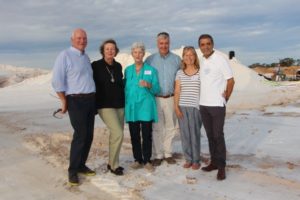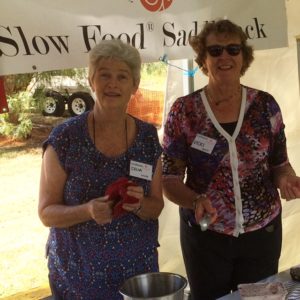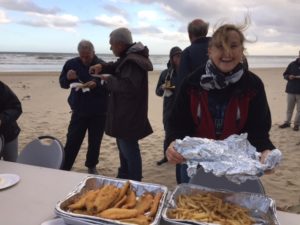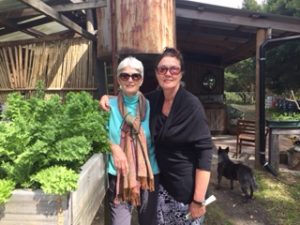Just a little update on Slow Food Saddleback’s representation at the National Conference in Mildura. Refer to the New Letter sent last week for details .info@slowfoodaustralia.com.au








Just a little update on Slow Food Saddleback’s representation at the National Conference in Mildura. Refer to the New Letter sent last week for details .info@slowfoodaustralia.com.au









This wonderful event was dreamed up by Hellen Attwater and she did a fantastic job. Over 40 people braved the threatening weather for Slow Fish and Chips. She sourced local mullet and had it cooked at Gerringong Fish Shop. It was delivered hot and scrumptious and was very well received on a blustery beach evening. An assortment of salads and desserts were also served.
No matter how much howling we did we couldn’t get that MOON to peak through the cloud cover.

However as we were driving home it suddenly emerged. Even the best planned events can’t organise the moon to perform on request.

Sunday 16 October
I was recently given the opportunity to observe the humane killing of a farm animal, as well as some chickens. During my rather long time on Planet Earth, this was not something I had ever experienced and I thought it was a good chance for me to fill in the gaps in my knowledge of such things.
The venue was a tranquil rural setting with green paddocks rolling away in the distance to a rain forest. Horses, cows and goats grazed in the paddocks and in the clear morning light, the countryside was serene.
The kindest method of slaughtering was explained by an experienced woman who has been handling animals since she was a young girl. She imparted her extensive knowledge with great sensitivity and was calm and practical before the procedure; the animal was not stressed at any time and neither were the onlookers.
The subsequent skinning and butchering was carried out efficiently to ensure the quality of the meat was not compromised and valuable knowledge about the different cuts was explained. A rooster and several chickens were also dispatched in a similarly humane fashion and none of the birds were stressed at any time. Overall, it was a fascinating way to learn about farm life and the respect shown to all the animals in the food chain was heartening to observe.
Jan Watson (Member of Slow Food Saddleback)
On Sunday October 9th, Vicki and Celia set up shop to promote this wonderful local Seaweed product. There was lots of interest and we sold quite a lot of product on the day. This was a good follow on from the lunch we held earlier in the year with Pia Winberg at the Old Schoolhouse, Gerringong
Phyco Food Co. will be featured on ABC Landline in coming weeks and BBC have been filming new recipes too. Pia recently won a gold medal at the Melbourne Good Food Awards for the Phukka (Dukka) seaweed blend product. Check out http://www.phycofood.co/
Thank you Tricia for providing us a table at your stall.

On Sunday 16th October, thirty Slow Food Saddleback members and friends were treated to an amazing day, hosted by Helen Attwater and Astra Temple.


Astra instructed the group on the humane dispatch of a goat and six cockerels on the day.
Helen prepared dishes from locally sourced produce, goat and cockerels that were prepared prepared a few days earlier.
The Stables provided protection from the strong northerly wind on the day.
A long table setting provided a relaxed, slow feast of fine food and friendship.
Helen must be congratulated it was a lot of hard work for her. Everyone was thrilled with the day.
A BIG THANK YOU HELEN AND ASTRA ………….WELL DONE !


On Thursday October 8th a small group of members met for the first of hopefully more breakfast meetings. The AGM was soon completed and the office bearers, Celia as Leader and Michael as Treasurer will remain for 2016/17. We have a couple of new committee members to welcome too.
Tess from Jamberoo Valley Farm provided a tasty morning tea, then gave us all a fascinating tour of the farm, pigs, chickens, ducks and fish as well as beautiful health herbs and vegetable flourish. She shared her plans for the future Agrarian Kitchen with us.

Thank You Tess for sharing your Slow Food way of life with and we look forward to sharing and supporting your ventures in the future.
The original school orchard was planted on National Tree Day in July 2015, sponsored by Slow Food Saddleback (SFS). The trees are thriving and at the celebration of a year on held 5 August Slow Food donated another tree, and joined the primary school community for the tree planting, followed by sampling of many things citrus!! Cakes, biscuits and marmalade topped the tasty list of goodies.
Carolyn Evans from SFS put together a citrus recipe collection that will be a great guide when all those trees are laden with nutritious fruit. Michael and Beverley Blythe presented the School’s Acting Principal Lisa Morris with a grow your own fruit and vegetable reference book for the library.
The partnership between SFS and the school is valuable and promotes Slow Food principles. The School Gardening Grubs will continue to work with us to promote good eating habits and community participation in food production.
Breakfast and Annual General Meeting Tuesday 20 Sept, 9am. Details coming soon.
Helen Attwater will be hosting an interesting lunch at Eagleview Farm Foxground. Sunday October 16th. Invitation on its way soon!
Slow Food Saddleback Membership – You will be able to renew your membership through Slow Food Saddleback from now on – Details coming.
A lovely day for twenty Slow Food Saddleback members and friends to wander around Kiama’s Community Garden on the 30th July.
Joe, Maria and Julie proudly lead us through the garden and answered all our questions. They are a very busy group and would welcome any support members and friends can offer.


Gabriella’s Pumpkin, Julie’s Artichoke and Maria’s Broccoli/blue cheese soups, all prepared from garden produce were enjoyed with flatbread cooked in the pizza oven by Rayner. We donated $220 toward the commercial kitchen project for the garden.
Rayner has sent me a link to his favourite recipe of the moment. it is very good reading. http://www.georgeandgianna.com/#!Umbria-II/coco/56d9411c0cf20d226f1e41f5
Earlier this month 36 members and friends were treated to a fabulous lunch created by Kirsten McHugh of the Gerringong Schoolhouse using Dr Pia Winberg’s Phyco Food Co. Seaweed products produced in the Shoalhaven. Pia uses a bi-product from the Manildra plant to grow the seaweed and explained how pre-biotic fibre and Omega 3 is very beneficial to our gut health and how gut health is instrumental in our general health. Pia gave a very informative talk on her recent Bio Belly research and these results are in the process of being written up for publication in scientific journals. She also talked about the research she has undertaken with the Nowra Prison inmates and the Omega 3 deficiencies she found in this study. She has now branched out into a commercial venture marketing Phyco Food Co.* products online www.phycofood.co. The seaweed pasta was nominated at the National Food Awards in Melbourne recently.


Kirsten’s imaginative house made menu included Phukka* dusted grissini and crackers with Phycotein*spiced Schoolhouse Haloumi for starters, then the most delicious entree of eggplant and wakami wontons in a spiced wakami broth. The main course consisted of a tasty nori and nettle gnocchi and served with a nori-enriched beef ragu (beef from Helen and Bernard’s Eagleview Farm at Foxground) and a crisp salad of cabbage, fennel, lemon and Australian Ulva. Dessert was Schoolhouse Yoghurt Pannacotta with Davidson plum syrup and delicate seaweed dusted meringue. It was a very busy day for Kirsten, however she managed to introduce us to each dish. Kirsten’s cheeses and yoghurt products are available through Greenbox each week at www.greenbox.org.au
It was wonderful to share this event with the orignial founders of Slow Food Saddleback, Kirsten McHugh and Jack Timbs. Oh! and I almost forgot, (kidding) Jack gave a well researched and very entertaining introduction to Pia on the day.
Thank you Pia, Kirsten and Jack, we hope we can share another event in the near future.
Keep Saturday 30th July FREEEEEE.
Slow Food Saddleback will join forces for a day in Kiama’s Community Garden. We will enjoy hearty soups made fresh from the garden and hopefully some freshly baked bread from the pizza oven.
This event supports the Community Garden’s fundraising for a toilet at the garden. We will be asking for donations on the day.
nbsp;
Kiama Farmers Market invited Slow Food to participate in the Seniors Week festivities on 6th April. We decided to focus on “end of summer corn” We prepared lots of corn on the cob and corn fritters from Bill Granger’s recipe served with an avocado and finger lime salsa and a tamarillo chutney.
Look for the recipe in the recipe section.
(Corn is a particularly good example of the importance of the Slow Food Movement. After reading the Omnivore’s Dilemma by Michael Pollan, his description of GM corn and its impact on farming communities in the USA inspired me to join Slow Food Saddleback. He describes the importance of diversity, thinking and questioning farming methods used in food production today) Its worth the read to help you grasp the SLOW in the Slow Food Movement.
Celebrity Chef James Reeson of WIN TV Alive and Cooking entertained the crowds by cooking a selection of market produce during the afternoon.
Slow Food Australia formed a working group at the last Conference in Ulladulla late last year. The aim is to increase membership, provide more information both for members and the general public, and streamline and encourage the Ark of Taste process.
The group has been hard at work with monthly telephone meetings, and communication and working party meetings in between.
As leader of Slow Food Saddleback convivium, I am on that group and am amazed by the amount of information we have dealt with, and the work involved with preparation for the 2016 Terra Madre Salone de Gusto in Turin, Italy later this year. Obviously trying to budget for web site development, membership kits and getting both product and Chefs and producers to Turin in September is upfront at present.
I can only congratulate the chair of the group Deb Bogenhuber from Mildura for keeping us on track and moving forward. Of course she is also heavily involved with planning for this year’s Conference in Mildura in November – I would recommend you attend if possible, it will be a stimulating, fun and good eating event. More details later, so follow the web site for updates.
I don’t want to bore you with detail, but I am aware that some of our members are very keen to know more about the International body and its purposes. In my next post I will update you on some of the International activities.
But here is how the Australian organisation works!
Slow Food Australia governance structure
Members
Working groups
Leadership group
Australian Councillor
International Liaison
Ark of Taste Commission
Terra Madre Salone del Gusto 2016
This event is Turin later this year will have about 25 delegates from Australia, with food and other activities represented each day. I will update you on the plans in my next letter, but it is exciting to see Australian farmers and chefs being sponsored by local Slow Food convivia and able to bring Australia to this prestigious event.
WHAT’S IN SEASON – April 2016
As we move towards the end of summer, there is still the abundance of summer vegetables available, masses of different varieties of tomatoes, cucumbers, eggplants, zucchinis, as well as so many greens – lettuce, kale, silverbeet and chard. The cooler weather is bringing delights such as some delicious Berlotti beans, fennel and golden as well as red beetroot, celeriac and fennel. Many are coping with masses of basil at the end of the season and still there is an abundance of chillies and herbs. New season very early local ginger and Jerusalem artichokes are just appearing In our area, while any olives which the birds have left, are ready to pick and pickle for later. New season potatoes such as Dutch creams, Kiffler, Sebago and Maranka are now available. Look out for the first pine and other types of mushrooms as the days get cooler.
There are now many varieties of new season apples appearing, including the later Pink Lady and Granny Smith and various heritage varieties. Nashi pears, pears and quinces as well as crabapples and strawberry quavas, will keep us busy making delicious jellies and tarts. It is prime season now for juicy figs, which will finish shortly but also for rhubarb, pomegranites and custard apples, all of which have a short season. All types of melons are delicious at present. The first early season mandarins are available but thankfully limes and lemons are much cheaper than a few months ago.
Autumn is a prime time for seafood with fish such as slimy mackerel, King George whiting, tuna both yellow fin and albacore being especially abundant and delicious at present. Even sea mullet is good and can be cooked and smoked to give a delicious reasonable meal, high in omega 3 oils Southern calamari and oysters from Merimbula are available as well as a variety of crabs from South Australia.
Pork, ham and bacon are the best buys at present of all the red meats, with both lamb and beef remaining expensive as farmers have reduced stock as the pastures dry following long dry spells. However after many lean years, farmers are realising good prices for their animals. Free range chicken is reasonably priced and a variety of game birds are available now.
The summary below gives some information about Meat Standards Australia and their means of assessing beef and lamb so that the consumer can be sure of the quality of the meat and buy the right cut for the dish they wish to prepare. Check it out and look for the logo when you next buy beef or lamb, those butchers selling these products will have them clearly marked.
The recipe below is delicious and easy and uses several ingredients in season at present.
Pepper and fennel-crusted tuna with figs
Ingredients
Method
BUYING MEAT
The summary below gives some information about Meat Standards Australia and their means of assessing beef and lamb so that the consumer can be sure of the quality of the meat and buy the right cut for the dish they wish to prepare. Check it out and look for the logo when you next buy beef or lamb, those butchers selling these products will have them clearly marked.
MEAT STANDARDS AUSTRALIA
Meat Standards Australia (MSA) is a grading system proven to take the guess work out of buying and cooking Australian beef and lamb. All products identified with the MSA symbol have met strict criteria to ensure they achieve consumer expectations for tenderness, juiciness and flavour. A cut of beef or lamb meets the MSA standard it is cut to, or labelled with a recommended cooking method which confirms that cut has achieved the standard for eating quality, when prepared by the recommended cooking method.
How the MSA grade is calculated
MSA certified graders collate information provided from the producer with a number of attributes measured on each carcase, for beef cattle these include; meat colour, marbling, fat depth, carcase weight, maturity and ultimate pH. This information is entered into a hand held data unit containing the MSA grading model which generates an eating quality grade for each cut based on a specific cooking method.
Integrity of the system
All participants in the supply chain from the producer through to transport, abattoir and butcher, are licensed to use the MSA symbol. There is a complete traceability from paddock to plate. If the symbol is used at the point of purchase the retailer or restaurateur must have an approved Quality Management System that meets requirements set out in the MSA Standards Manual. Licensees are subject to a random audit for compliance to the standard, while the MSA standards are audited against the AS/NZS ISO 9001/2008 Standard.
Production of MSA graded beef and lamb
Production and management practices are key factors that influence the eating quality potential of cattle, sheep and lambs. Below is a summary of these key factors, their impact and how they are measured to identify consistent quality beef and lamb.
Breed
All breeds are eligible for MSA grading. However, research shows that breed can impact the eating quality of certain cuts. An assessment of breed content is made prior to processing.
Nutrition and growth
Cattle and sheep must be finished on a rising plane of nutrition to ensure adequate growth and sufficient muscle glycogen levels prior to processing. Glycogen is a measure of an animal’s energy reserves. Adequate nutrition and minimal stress during handling results in high muscle glycogen which leads to optimal pH and meat colour compliance at grading.
Handling and Transport
Livestock must be handled in a manner that minimises stress during mustering and transport. Stress is a major contributor to a condition that results in dark, tough beef.
Grading a Carcase
Production inputs are combined with carcase attributes to develop a MSA grade for a specific cut of beef or lamb. Specific carcase attributes and they importance are summarised below.
Meat Colour
The colour of the rib eye muscle is assessed and scored against a nationally approved standard. Meat colour is a leading indication of meat quality as dark beef is known to be tough and unacceptable.
MSA Marbling
Marbling is a measure of intramuscular fat and a lead indicator of flavour and tenderness. The rib eye muscle is assessed to calculate the amount and distribution of marbling against the MSA standard.
External Fat Distribution
An even fat coverage assists uniform carcase chilling which influences tenderness. The thickness of rib fat is measured at a standard location; it must be at least 3mm to meet the MSA standard. External fat must also be evenly distributed over the loin, hind and forequarters.
Ultimate pH
pH is the measurement of lactic acid in the muscle. It is a key indicator of eating quality and is measured by inserting a pH probe into the eye muscle. Only carcases with the optimum pH level achieve an MSA grade.
Maturity
Maturity is measured in beef cattle by assessing the amount of cartilage that turns to bone along the spine. It describes how quickly the animal has grown and is a lead indictor of beef tenderness. A lamb is determined by the AUS-MEAT classification based on the number of permanent teeth it has at the time of processing.
Reading Carton labels
All MSA graded beef and lamb is identified on the carton end panel with the prefix MSA. The label must state;
MSA product must not be sold to consumers before it reaches the MSA ageing requirement shown on the carton label. To do this check the date it was packed on or the carcase ticket for the date of processing and calculate forward for a release date. All MSA products require a minimum ageing period of 5 days. The MSA standard for beef can be met by a number of ageing requirements up to 35 days. The ageing requirements for beef change depending on the cut.
How to Identify a MSA Primal
All MSA vacuum packed beef, lamb and sheepmeat products must be identified with either a heat printed MSA logo on the bag, an MSA insert or approved MSA brand insert. In the absence of an approved insert or bag logo the product cannot be sold as MSA.
Carolyn Evans
Autumn In the veggie garden.
To prepare for the coming autumn, start clearing the veggie beds of the summers flagging tomatoes, eggplants, cucumber and zucchinis, however if you have pumpkins not quite ready to harvest, work around them!
The beds will then be refreshed with some compost, chicken poo, soil and mulch and be ready to plant the next crops after the next local markets where you can obtain healthy seedlings. Thanks to http://www.gardenate.com Helen will plant the recommended selection below over the next 3 months.
Plant Garlic March/April in well-drained soil with good organic matter and manure, keep watering through spring, harvesting in summer.
(with the exception of Strawberries which should be planted in April these can all go in over the 3 months of autumn) beans, broad beans, green beans, beetroot , broccoli, brussel sprouts, cabbage, carrot, cauliflower, endive, fennel, garlic, kale, leeks, lettuce, onions, peas, radish, rocket, shallots, silver beet, english spinach, turnips & swedes.
May planting: The warm temperate climate on the South Coast allows us to grow a variety of vegies over the winter months. Vegies to plant in May are asian greens, asparagus crowns, broccoli, cabbage, cauliflower, celery, garlic, kale, leek, lettuce, onion, peas, radish, silver beet, spinach & turnip & herbs such as coriander, oregano, rocket, sage, thyme, and of course sow some more strawberries.
Happy Planting Helen Attwater
Twenty members and friends enjoyed a fun evening at the Berry home of Judith and David Ball on March 19th. We shared the evening with their grand daughter and her friends to celebrate a belated 13th Birthday. It was a fun evening and the pizza concoctions were amazing.
Judith and David guided us through their secrets of pizza making from the dough, topping and cooking process. David walked us through his productive vegetable garden and we sampled his home brewed beer that he has perfected over many years.
This was a very special evening and we hope we are invited back. We could maybe have a pizza competition. Judith and David could be the judges.
Thank you Judith and David from all who attended.